Segregation of fluorescent membrane lipids into distinct micrometric domains: evidence for phase compartmentation of natural lipids?
- PMID: 21386970
- PMCID: PMC3046177
- DOI: 10.1371/journal.pone.0017021
Segregation of fluorescent membrane lipids into distinct micrometric domains: evidence for phase compartmentation of natural lipids?
Abstract
Background: We recently reported that sphingomyelin (SM) analogs substituted on the alkyl chain by various fluorophores (e.g. BODIPY) readily inserted at trace levels into the plasma membrane of living erythrocytes or CHO cells and spontaneously concentrated into micrometric domains. Despite sharing the same fluorescent ceramide backbone, BODIPY-SM domains segregated from similar domains labelled by BODIPY-D-e-lactosylceramide (D-e-LacCer) and depended on endogenous SM.
Methodology/principal findings: We show here that BODIPY-SM further differed from BODIPY-D-e-LacCer or -glucosylceramide (GlcCer) domains in temperature dependence, propensity to excimer formation, association with a glycosylphosphatidylinositol (GPI)-anchored fluorescent protein reporter, and lateral diffusion by FRAP, thus demonstrating different lipid phases and boundaries. Whereas BODIPY-D-e-LacCer behaved like BODIPY-GlcCer, its artificial stereoisomer, BODIPY-L-t-LacCer, behaved like BODIPY- and NBD-phosphatidylcholine (PC). Surprisingly, these two PC analogs also formed micrometric patches yet preferably at low temperature, did not show excimer, never associated with the GPI reporter and showed major restriction to lateral diffusion when photobleached in large fields. This functional comparison supported a three-phase micrometric compartmentation, of decreasing order: BODIPY-GSLs > -SM > -PC (or artificial L-t-LacCer). Co-existence of three segregated compartments was further supported by double labelling experiments and was confirmed by additive occupancy, up to ∼70% cell surface coverage. Specific alterations of BODIPY-analogs domains by manipulation of corresponding endogenous sphingolipids suggested that distinct fluorescent lipid partition might reflect differential intrinsic propensity of endogenous membrane lipids to form large assemblies.
Conclusions/significance: We conclude that fluorescent membrane lipids spontaneously concentrate into distinct micrometric assemblies. We hypothesize that these might reflect preexisting compartmentation of endogenous PM lipids into non-overlapping domains of differential order: GSLs > SM > PC, resulting into differential self-adhesion of the two former, with exclusion of the latter.
Conflict of interest statement
Figures

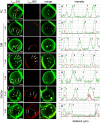
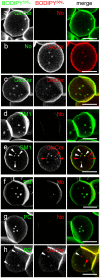
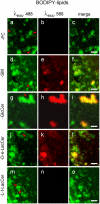
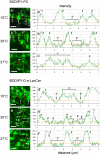
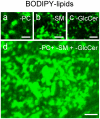
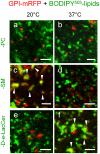




Similar articles
-
Three unrelated sphingomyelin analogs spontaneously cluster into plasma membrane micrometric domains.Biochim Biophys Acta. 2010 May;1798(5):909-27. doi: 10.1016/j.bbamem.2010.01.021. Epub 2010 Feb 1. Biochim Biophys Acta. 2010. PMID: 20123084
-
Micrometric segregation of fluorescent membrane lipids: relevance for endogenous lipids and biogenesis in erythrocytes.J Lipid Res. 2013 Apr;54(4):1066-76. doi: 10.1194/jlr.M034314. Epub 2013 Jan 14. J Lipid Res. 2013. PMID: 23322884 Free PMC article.
-
Surfactins modulate the lateral organization of fluorescent membrane polar lipids: a new tool to study drug:membrane interaction and assessment of the role of cholesterol and drug acyl chain length.Biochim Biophys Acta. 2013 Sep;1828(9):2064-73. doi: 10.1016/j.bbamem.2013.05.006. Epub 2013 May 17. Biochim Biophys Acta. 2013. PMID: 23685123
-
Use of Bodipy-labeled sphingolipid and cholesterol analogs to examine membrane microdomains in cells.Histochem Cell Biol. 2008 Nov;130(5):819-32. doi: 10.1007/s00418-008-0509-5. Epub 2008 Sep 27. Histochem Cell Biol. 2008. PMID: 18820942 Free PMC article. Review.
-
Atom-scale molecular interactions in lipid raft mixtures.Biochim Biophys Acta. 2009 Jan;1788(1):122-35. doi: 10.1016/j.bbamem.2008.08.018. Epub 2008 Sep 6. Biochim Biophys Acta. 2009. PMID: 18817748 Review.
Cited by
-
Endogenous sphingomyelin segregates into submicrometric domains in the living erythrocyte membrane.J Lipid Res. 2014 Jul;55(7):1331-42. doi: 10.1194/jlr.M048538. Epub 2014 May 14. J Lipid Res. 2014. PMID: 24826836 Free PMC article.
-
Regulation of macrophage motility by the water channel aquaporin-1: crucial role of M0/M2 phenotype switch.PLoS One. 2015 Feb 26;10(2):e0117398. doi: 10.1371/journal.pone.0117398. eCollection 2015. PLoS One. 2015. PMID: 25719758 Free PMC article.
-
PDGF-induced fibroblast growth requires monounsaturated fatty acid production by stearoyl-CoA desaturase.FEBS Open Bio. 2017 Feb 2;7(3):414-423. doi: 10.1002/2211-5463.12194. eCollection 2017 Mar. FEBS Open Bio. 2017. PMID: 28286737 Free PMC article.
-
Plasma Membrane Lipid Domains as Platforms for Vesicle Biogenesis and Shedding?Biomolecules. 2018 Sep 14;8(3):94. doi: 10.3390/biom8030094. Biomolecules. 2018. PMID: 30223513 Free PMC article. Review.
-
Cholesterol segregates into submicrometric domains at the living erythrocyte membrane: evidence and regulation.Cell Mol Life Sci. 2015 Dec;72(23):4633-51. doi: 10.1007/s00018-015-1951-x. Epub 2015 Jun 16. Cell Mol Life Sci. 2015. PMID: 26077601 Free PMC article.
References
-
- Singer SJ, Nicolson GL. The fluid mosaic model of the structure of cell membranes. Science. 1972;175:720–731. - PubMed
-
- Singh RD, Liu Y, Wheatley CL, Holicky EL, Makino A, et al. Caveolar endocytosis and microdomain association of a glycosphingolipid analog is dependent on its sphingosine stereochemistry. J Biol Chem. 2006;281:30660–30668. - PubMed
-
- Brown DA, London E. Functions of lipid rafts in biological membranes. Annu Rev Cell Dev Biol. 1998;14:111–136. - PubMed
-
- Simons K, Ikonen E. Functional rafts in cell membranes. Nature. 1997;387:569–572. - PubMed
Publication types
MeSH terms
Substances
LinkOut - more resources
Full Text Sources
Miscellaneous

